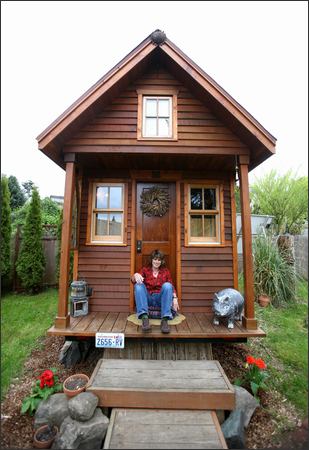The Small House Movement
A growing number of homeowners in the U.S. are downsizing to homes smaller than 1,000 square feet, and, in some cases, smaller than 100 square feet. This transition to smaller homes, known as the Small House Movement, is adhered to by people who believe American houses in general are too large, wasteful and energy-inefficient.
The disadvantages of downsizing are obvious: you may have to get rid a lot of furniture, the new house is less prestigious, and you lose space for guests. Neighbors, too, might view your small home as a threat to their property values. But living small is nothing new. After World War II, 1,000-square-foot homes were the norm for returning soldiers and their families.
Gayle Butler, editor-in-chief of Better Homes and Gardens, describes the Small House Movement as "right-sizing," rather than downsizing, as homeowners forgo unused space and buy homes that better fit their needs. Dee Williams, of Olympia, Washington, sold her 1,500-square-foot home and moved into an 84-square-foot home that she built herself. When the electric company began charging more for electricity, her bill doubled from $4 to $8, an increase that probably would have been more dramatic in her previous home.
Adherents to the Small House Movement enjoy the following perks of their transition:
- increased cash flow. Smaller homes require a smaller mortgage, lower property taxes, and decreased homeowner’s insurance, maintenance costs, and the expense required to furnish the home. Owners might even be able to purchase a smaller house in cash using the proceeds from their existing home. And with the extra money, they can afford improved insulation, higher-quality windows and flooring, and luxuries such as solar roof panels and skylights;
- less maintenance. Fewer rooms and smaller spaces cut down on the time needed to clean and maintain, leaving more hours in the day for more enjoyable activities;
- lower utility bills. It costs a lot less to heat and cool a small home than a large home. Typically, there is no wasted space in vaults in a small home;
- reduced consumption. If there is little space to store items, homeowners are much less likely to buy new things. Fewer rooms and windows mean less money spent on TVs and curtains, for instance;
- more time with family. Less space means that more room must be shared, which encourages group activities and dinners.
- Use items for more than one purpose. For example, you can use a trunk as a coffee table, placing in it items such as shoes, files, and extra sheets to save closet space.
- Eliminate or cut down on extra silverware, pots, pans and dishes if the kids have moved out.
- Use rooms for more than one purpose. You may be able to squeeze a small computer desk into the corner of a bedroom, and a rarely-used dining room can double as a library.
- Purchase a stackable washer/dryer unit to save space.

